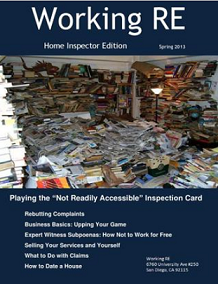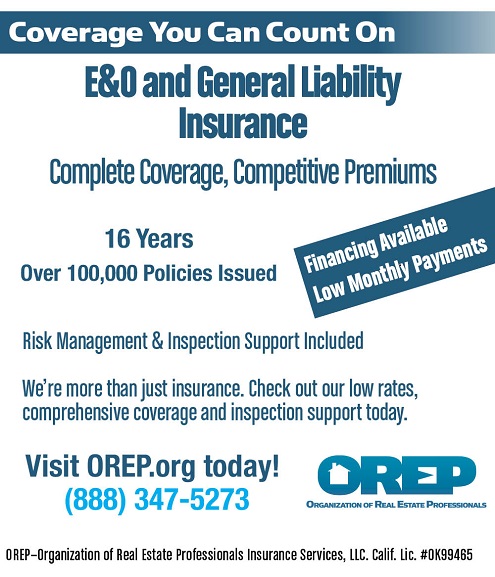 |
>> See Past News Editions >> Follow our NEW Home Inspector RSS Feed >> Click to Print >> Note: If you live in “high-priced” states like AZ, CA, IL, NJ, PA, FL, TX or WA, OREP does not limit coverage or raise your rates. The same rates apply in all states where program is offered. Same day coverage. |
Pricing Your Services – Strategies and Considerations (Part 2)
By Alan Carson- Carson, Dunlop & Associates Ltd.
In last month’s article, we briefly introduced pricing your services using a few strategies. This month, we will discuss more regarding strategic pricing. That is, does it make sense to use flat rates or use a price matrix.
Flat Rate or Price Matrix?
Some home inspection companies charge a flat rate regardless of the home size or age. The benefit of flat-rate pricing is that it’s simple for your clients to understand. The rationale for this strategy is that even on a very large home, there is only one electrical system, one heating system, and so on. The actual open space in the home doesn’t take much incremental time to inspect within a reasonable size range. Furthermore, on average, your time works out pretty evenly spread across many homes. Some houses take more time, and some take less time.
Flat-rate pricing might work in an area where you don’t typically see many very large homes, or very old homes, but for most home inspectors, some kind of price matrix makes more sense for two reasons:
1. Big homes do take longer. In our area, most homes that are over 5,000 square feet will have two heating systems and two or three electrical breaker panels. In addition, there will be three to five bathrooms instead of one or two. And, frankly, it does take more time to inspect 4,000 square feet of roof than 1,000 square feet.
2. Old homes take longer. Many home inspectors charge more for a home that is older than 25 or 50 years. There are more renovations, additions, wear and tear, and mixing and matching of different systems.
Even if the possibility of charging more does not interest you, once you get fully booked, you will recognize that the additional time on the larger and older homes will throw off your schedule, often making you late for the next inspection. From a scheduling perspective alone, you need to know the age and size of the home.
Two additional areas where you may want to charge more are:
1. multi-unit residences, and
2. areas far from your territory, especially if there is nobody else servicing those areas.
There are other ways to set your fee. Many home inspection companies set their fee based on the selling price of the house. Because the scale is rough, people don’t perceive that you are charging more just because they are buying an expensive house.
The rationale is that a more expensive home in a given area is going to be larger.
Furthermore , many homebuyers don’t know how many square feet the home is, so purchase price may be a better indicator than size in determining an appropriate fee.
(story continues)
For many years, we based the inspection fee on the purchase price of the home. The price schedule looked like this:
• Homes under $350,000 were a flat fee of $350.
• Homes over $350,000 to $400,000 were a flat fee of $425.
This turned out to be a very good price matrix. We almost never ran into scheduling problems, and the fee was almost always justified by the size of the home. Occasionally we got into a home that was very expensive based on the location, but was actually a very small home. In this case, we would reduce the fee. We did this without a hitch for almost 20 years, with regular increases in fees and adjustment of the schedule.
More recently, we received some feedback from the real estate community who felt we were penalizing their wealthy clients. We had little choice but to change the price matrix to reflect the number of square feet. Our biggest objection to the price-based-on-square-feet approach was many clients didn’t know how many square feet the house was. Often we would arrive at an inspection to find that the 1,500 square foot home was actually 1,500 square feet per floor, not to mention that it had three stories plus a basement. While it’s easy to reduce a fee on site, it’s almost impossible to raise the fee on site!
If people don’t know how many square feet the house is, we ask the following questions and make a best guess:
• Is it a big house or a little house?
• How many floors?
• How many bedrooms?
• How many bathrooms?
• Is the house as wide as it is long?
You can usually get a rough idea of square feet with this information. If a client says, “I think it’s 1,500 square feet, but it has three bathrooms and five bedrooms and three stories,” you might guess that it’s 1,500 square feet per floor.
Our price matrix has looked like this:
| Size | Less than 25 Years Old | 25 Years Old and Up |
| Up to 2000 sq. ft. | $429 | $429 |
| 2001 to 2500 sq. ft. | $445 | $445 |
| 2501 to 3000 sq. ft. | $445 | $535 |
| 3001 to 3500 sq. ft. | $535 | $545 |
| 3501 to 4000 sq. ft. | $545 | $669 |
| 4001 to 4500 sq. ft. | $559 | $719 |
| 4501 to 5000 sq. ft | $719 | $749 |
| 5001 to 5500 sq. ft. | $749 | $919 |
| 5501 to 6000 sq. ft. | $769 | $1,019 |
| 6000 sq. ft and up | $1,025 | $1,025 |
| Triplex | A minimum charge of $535 | |
| Fourplex | A minimum charge of $749 | |
As you can see, there are many ways to break down your fee. One strategy may make more sense than another in your area. Either way, the first thing you should do is find out how much other inspectors are charging.
Advantage to Staged Pricing
Staged pricing allows you to quote a base fee that sounds reasonable. As you get more details, the price may increase, but by then you often have the client committed to your benefits. If your high fee prevents people from calling you in the first place, you won’t have a chance to win them over.
The strategies and considerations discussed here may or may not be suitable for your business. It has worked for us and is something we wanted to share as a starting point for you to consider how you should price your inspections. As with many things, there may be some trial and error to determine if it aligns well with your particular business strategy.
Reprinted from the ASHI Reporter, June 2014 edition.



by Eli Manning Jerseys
Hi, after reading this remarkable article i am too delighted to share my knowledge
-here with mates.
by Lindsay Holmes
Your article was very helpful. I use a square foot matrix and add on for building’s age and crawl space. I usually give the client the fee quote over the phone while booking based on the interview. Your fee schedule is quite a bit more than we can charge in our area, so I’m assuming your location is near the coast.
-by John R.
The article fails to mention that pricing is heavily dependent upon what market you are in. Specifically, how much competition do you have and what is your local competition charging. Nothing wrong with being near the top with your pricing, but make sure it’s not excessively over the top, or you will lose out on a lot of business. Areas such as Chicagoland where we are somewhat saturated with inspectors, pricing yourself competitively is important.
-